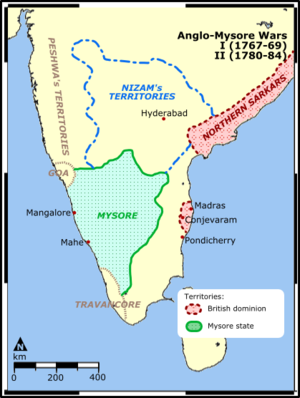First Anglo-Mysore War
| First Anglo–Mysore War | |||||||
|---|---|---|---|---|---|---|---|
| Part of the Anglo-Mysore wars | |||||||
 A map of the war theatre |
|||||||
|
|||||||
| Belligerents | |||||||
|
|
|
||||||
| Commanders and leaders | |||||||
|
|
|
||||||
The First Anglo–Mysore War (1767–1769) was a conflict in India between the Sultanate of Mysore and the East India Company. The war was instigated in part by the machinations of Asaf Jah II, the Nizam of Hyderabad, who sought to divert the company's resources from attempts to gain control of the Northern Circars.
The eighteenth century was a period of great turmoil in the Indian subcontinent. Although the century opened with much of the subcontinent under the control of the Mughal Empire, the death in 1707 of Emperor Aurangzeb resulted in the fracturing of the empire, and a struggle among viceroys and other local rulers for territory. In the 1740s and 1750s French and British colonial companies became more active in these local conflicts, and by the Third Carnatic War (1757–1763) the British had not only gained somewhat solid footholds at Bombay, Madras, and Calcutta, but they had also marginalised but not eliminated the influence of other colonial powers. Their eastern holdings at Madras were strongly influenced by treaties with the Nawab of Carnatic, Muhammed Ali Khan Wallajah, whose territory surrounded Madras. The other major powers in the east were the Nizam of Hyderabad, formerly a viceroyalty of the Mughul Empire but declared independent in the 1720s, held in the 1760s by Asaf Jah II, and the Sultanate of Mysore, which occupied the high plains between the Eastern and Western Ghats, the mountain ranges separating the coastal plains of India from the interior. Nominally ruled by the Wodeyar dynasty, control of Mysore had in 1761 come into the hands of Hyder Ali, a Muslim military leader. Each of these powers intrigued with and against the others, and sought to draw the power of the French and British colonial companies to serve their objectives. The colonial powers sought to influence the local powers to gain either direct control of territory, or the revenues from territory nominally controlled by a local ruler beholden to them for financial and military support. Since European military training was significantly better than local practices, the latter was particularly important; small numbers of disciplined European or European-trained forces could defeat significantly larger Indian armies composed mainly of poorly trained infantry and cavalry.
...
Wikipedia
